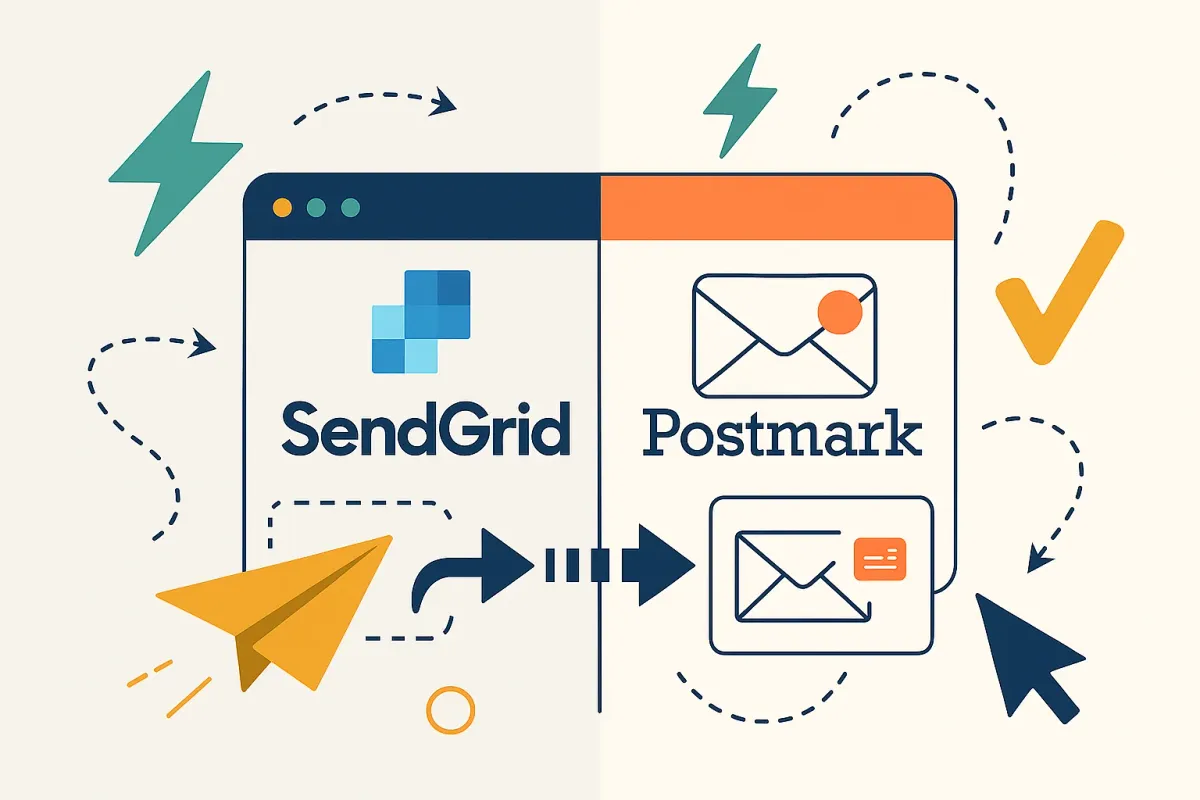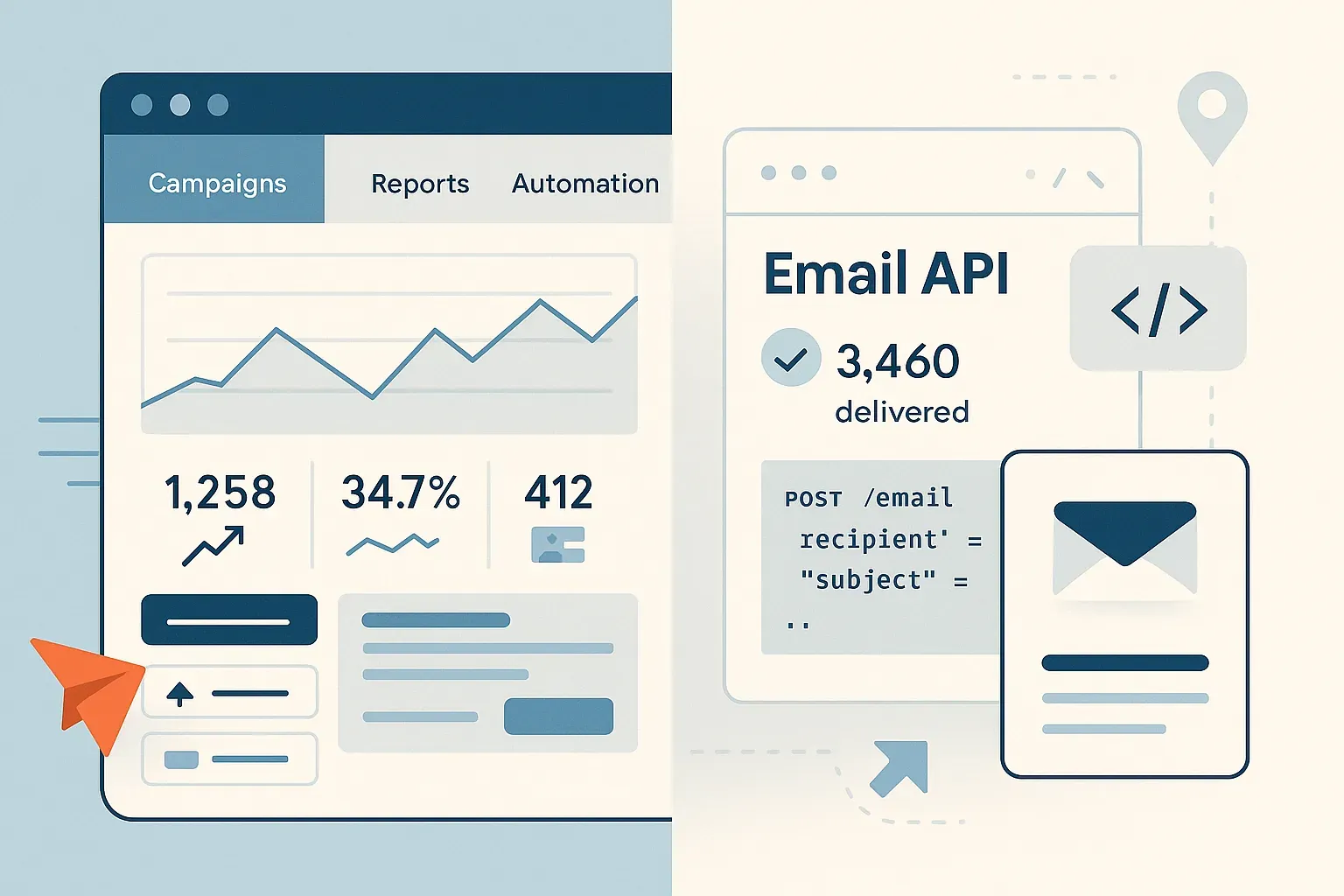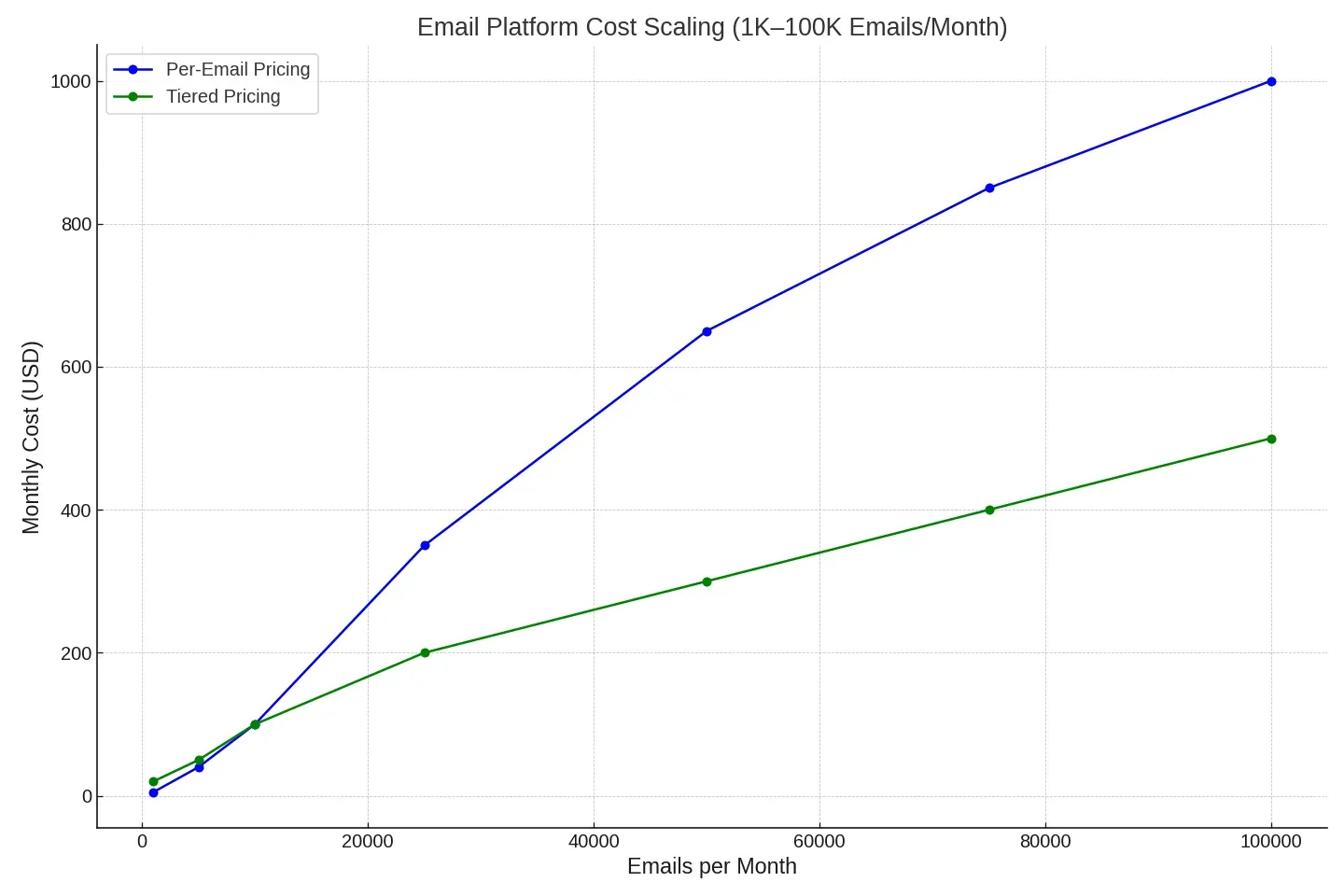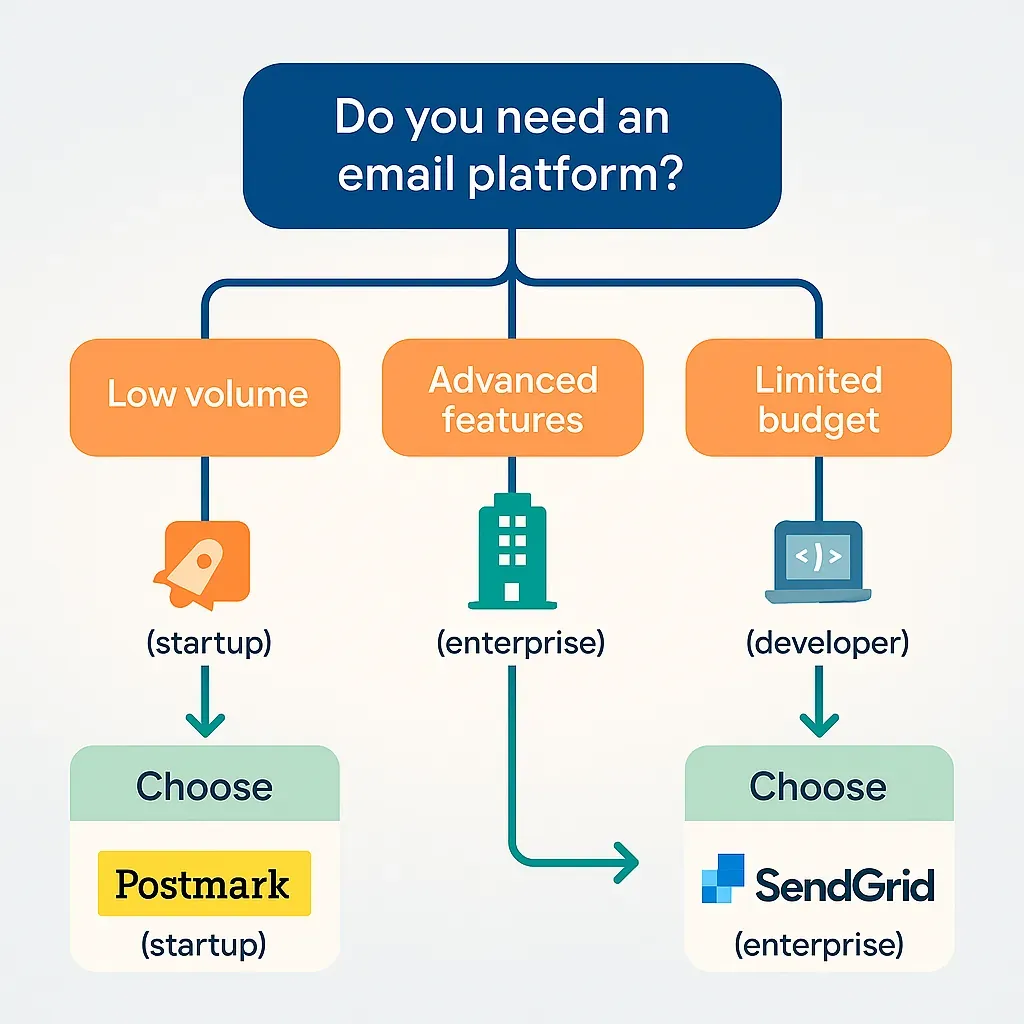SendGrid vs Postmark: Which Email Delivery Service is Right for You?
SendGrid vs Postmark comparison in 2025. Complete guide comparing costs, delivery performance, and developer experience for reliable email delivery.

Choosing between SendGrid and Postmark creates unnecessary complexity for development teams and growing businesses. Both platforms promise reliable email delivery, but their fundamental approaches, pricing models, and feature sets serve distinctly different use cases. This confusion often leads to costly migrations, integration headaches, and missed opportunities for email optimization.
The challenge extends beyond basic email delivery. Modern businesses need platforms that balance transactional reliability with marketing capabilities, developer-friendly APIs with user-friendly interfaces, and scalable pricing with predictable costs. Getting this decision wrong means either overpaying for unused features or lacking essential functionality when you need it most.
We've analyzed both platforms extensively, comparing their technical capabilities, pricing structures, integration processes, and real-world performance to help you make an informed decision based on your specific needs. Our analysis draws from industry deliverability benchmarks, email marketing statistics, and comprehensive platform testing data.
Groupmail's Integration Advantage: Best of Both Worlds
While choosing between SendGrid and Postmark creates implementation complexity, Groupmail eliminates this decision entirely through our native SendGrid integration. This strategic partnership combines SendGrid's enterprise-grade infrastructure with Groupmail's intuitive campaign management, delivering both reliability and usability.
Why Groupmail + SendGrid Works:
- Pre-configured authentication: SPF, DKIM, and DMARC setup handled automatically
- Optimized deliverability: Leverage SendGrid's dedicated IP pools and reputation management
- Simplified scaling: Volume-based pricing without per-email costs of alternatives
- Unified dashboard: Manage both transactional and marketing emails from one interface
- Expert support: Our team handles the technical complexity while you focus on campaigns
For businesses requiring Postmark's specialized transactional focus, we can accommodate custom integrations upon request. However, most organizations find that Groupmail's SendGrid integration provides superior long-term value by combining enterprise deliverability with comprehensive marketing capabilities—eliminating the need to manage multiple platforms or sacrifice functionality.
Ready to skip the SendGrid vs Postmark decision entirely? Start with Groupmail's integrated solution and get SendGrid's proven infrastructure with our intuitive campaign tools—no complex setup required.
TL;DR - Key Takeaways:
- SendGrid excels for businesses needing both transactional and marketing email capabilities with advanced analytics and A/B testing
- Postmark specializes in transactional email delivery with superior inbox placement rates and developer-focused tools
- Cost consideration: Postmark's pricing becomes expensive at scale, while SendGrid offers more predictable volume pricing
- Integration complexity: SendGrid provides more comprehensive APIs but requires steeper learning curve
- Alternative solution: Platforms like Groupmail combine enterprise-grade delivery with intuitive campaign management for teams wanting both capabilities without complexity
SendGrid vs Postmark: Core Platform Comparison
Quick Answer: SendGrid positions itself as a comprehensive email marketing and delivery platform, while Postmark focuses exclusively on transactional email delivery with premium inbox placement rates. SendGrid serves businesses needing both marketing and transactional capabilities, whereas Postmark targets developers prioritizing transactional email reliability over marketing features.
| Feature | SendGrid | Postmark |
|---|---|---|
| Primary Focus | Marketing + Transactional | Transactional Only |
| Monthly Free Tier | 100 emails/day | 100 emails/month |
| Starting Price | $19.95/month | $15/month |
| Volume Pricing | Scales with plans | Per-email pricing |
| Marketing Tools | Full suite included | None |
| API Complexity | Comprehensive | Streamlined |
| Analytics Depth | Advanced | Basic delivery |
SendGrid's strength lies in its dual capability—handling both your transactional emails (password resets, order confirmations) and marketing campaigns (newsletters, promotional emails) through a single platform. This unified approach simplifies management but adds complexity to the interface and pricing structure.
Postmark deliberately limits its scope to transactional emails, resulting in faster setup times and more predictable delivery performance. However, businesses requiring marketing capabilities must integrate additional tools, creating potential compatibility and cost complications.
💰 Cost Reality Check: Postmark's per-email pricing can reach $900/month for 100,000 emails, while SendGrid's equivalent volume costs $249/month through their Pro plan.

The fundamental architectural difference affects everything from onboarding complexity to long-term scalability. SendGrid's feature-rich environment requires more initial setup but provides comprehensive email management. Postmark's focused approach enables faster implementation but may necessitate additional tools as requirements evolve.
Delivery Performance and Reliability Analysis
Quick Answer: Postmark consistently achieves higher inbox placement rates for transactional emails, often reaching 98-99% delivery success rates compared to SendGrid's 95-97% average according to third-party deliverability testing. However, SendGrid's infrastructure handles higher volumes more cost-effectively, making it preferable for businesses sending over 50,000 emails monthly through SendGrid vs Postmark comparisons.
Both platforms maintain strong relationships with major ISPs and implement authentication standards like SPF, DKIM, and DMARC. Email authentication protocols are essential for maintaining sender reputation and ensuring inbox placement across all email service providers. The practical difference emerges in their infrastructure priorities and volume handling approaches.
Postmark's delivery advantage stems from its exclusive focus on transactional emails, which ISPs inherently trust more than promotional content. Their infrastructure optimization prioritizes delivery speed and inbox placement over volume capacity, resulting in consistently higher open rates and fewer spam folder placements according to email deliverability testing studies.
📊 Performance Insight: Independent testing shows Postmark achieving average delivery times of 2-5 seconds compared to SendGrid's 5-15 seconds for transactional emails, according to comprehensive deliverability research.
SendGrid's delivery performance varies significantly between transactional and marketing emails. Their transactional emails achieve comparable rates to Postmark, but marketing campaigns experience higher spam rates due to mixed IP reputation from diverse user bases.
For businesses prioritizing maximum inbox placement over cost efficiency, Postmark's specialized infrastructure provides clear advantages. However, organizations sending diverse email types benefit from SendGrid's balanced approach and reputation management tools.
The choice often depends on email volume and type distribution. High-volume senders generally achieve better overall performance with SendGrid's dedicated IP options, while low-to-medium volume senders benefit from Postmark's shared infrastructure optimization.
Developer Experience and Integration Complexity
Quick Answer: Postmark offers a more streamlined developer experience with simpler API documentation and faster integration times, typically requiring 2-4 hours for basic setup according to developer experience comparisons. SendGrid provides more comprehensive API capabilities but demands 1-2 days for full implementation when comparing SendGrid vs Postmark integration complexity.
API Design Philosophy
Postmark's API follows RESTful principles with straightforward endpoints designed specifically for transactional email scenarios. Their documentation includes practical examples for common use cases like password resets, purchase confirmations, and user notifications.
SendGrid's API provides extensive functionality covering both transactional and marketing use cases through their comprehensive v3 API reference. While more powerful, this comprehensiveness creates steeper learning curves and longer implementation timelines.
json
// Postmark API simplicity example
POST /email
{
"From": "sender@company.com",
"To": "user@example.com",
"Subject": "Password Reset",
"TextBody": "Reset your password here..."
}SDK and Language Support
Both platforms provide SDKs for major programming languages, but their approaches differ significantly:
| Language | SendGrid Support | Postmark Support |
|---|---|---|
| Python | Full-featured SDK | Lightweight SDK |
| Node.js | Comprehensive | Streamlined |
| PHP | Marketing + Transactional | Transactional focus |
| Ruby | Complete toolkit | Focused toolkit |
| Java | Enterprise features | Core functionality |
🔧 Integration Reality: Developers report 60% faster initial setup with Postmark based on platform comparison studies, but SendGrid's comprehensive features require less additional tool integration for growing businesses.
Webhook and Event Handling
SendGrid provides detailed webhook events for both delivery and engagement tracking, including clicks, opens, and unsubscribes. This comprehensive tracking supports both transactional monitoring and marketing analytics.
Postmark focuses on delivery-related webhooks with reliable bounce handling and delivery confirmations. Their webhook reliability tends to be higher, but the event scope is more limited.
For teams prioritizing development speed and simplicity, Postmark's focused API design reduces integration complexity. Organizations requiring comprehensive email management capabilities benefit from SendGrid's feature depth despite the additional implementation time.
Pricing Structure and Scalability Analysis
Quick Answer: Postmark's per-email pricing becomes prohibitively expensive beyond 10,000 monthly emails, while SendGrid's tiered plans provide predictable scaling for businesses comparing SendGrid vs Postmark costs. SendGrid offers better value for mixed transactional and marketing usage, whereas Postmark suits low-volume, high-priority transactional scenarios.
Detailed Cost Breakdown
Postmark Pricing Structure:
- Starter: $15/month for 1,000 emails
- Growth: $65/month for 5,000 emails
- Scale: $165/month for 15,000 emails
- Beyond: $0.011 per additional email
SendGrid Pricing Structure:
- Essentials: $19.95/month for 50,000 emails
- Pro: $89.95/month for 100,000 emails
- Premier: $249/month for 100,000 emails + advanced features
💸 Scaling Reality Check: At 25,000 emails monthly, Postmark costs $340 while SendGrid Pro costs $89.95, representing a 278% price difference for equivalent volume.

Hidden Cost Considerations
Postmark Additional Costs:
- Premium support: $200/month minimum
- Dedicated IPs: $50/month each
- Advanced analytics: Requires third-party tools
- Marketing capabilities: Separate platform needed
SendGrid Additional Costs:
- Dedicated IP: $29.95/month
- Additional contacts: Varies by plan
- Advanced analytics: Included in higher tiers
- Expert services: $500+ monthly
The pricing analysis reveals fundamental strategic differences. Postmark's premium positioning targets businesses where email delivery reliability justifies higher per-message costs. SendGrid's volume-based pricing accommodates businesses prioritizing scalability and comprehensive features over premium delivery rates, as detailed in email service pricing comparisons.
For startups and growing businesses, SendGrid's pricing structure provides more predictable growth costs. Established companies with critical transactional email requirements may find Postmark's premium pricing acceptable for guaranteed delivery performance.
Feature Comparison and Use Case Matching
Quick Answer: SendGrid provides comprehensive marketing automation, A/B testing, and campaign management alongside transactional delivery, making it ideal for businesses needing unified email operations. Postmark excels at transactional email reliability with superior delivery rates but lacks marketing capabilities, suiting developers focused on SendGrid vs Postmark transactional performance only.
Marketing Capabilities
| Feature | SendGrid | Postmark |
|---|---|---|
| Campaign Builder | Drag-and-drop editor | Not available |
| A/B Testing | Built-in functionality | Not supported |
| Contact Management | Advanced segmentation | Basic suppression lists |
| Automation | Full workflow builder | Not available |
| Templates | Marketing + Transactional | Transactional only |
SendGrid's marketing suite includes sophisticated segmentation, automated drip campaigns, and comprehensive analytics. These capabilities eliminate the need for separate marketing platforms, though they add complexity to the interface and pricing.
Postmark's deliberate exclusion of marketing features maintains their focused approach but necessitates additional tools for businesses requiring both transactional and promotional email capabilities.
Analytics and Reporting
SendGrid Analytics:
- Real-time delivery tracking
- Engagement metrics (opens, clicks, unsubscribes)
- Geographic and device analysis
- Revenue attribution tracking
- Custom event tracking
Postmark Analytics:
- Delivery confirmation tracking
- Bounce and spam monitoring
- Response time analytics
- Basic engagement metrics
- Webhook event logging
📈 Analytics Insight: SendGrid's marketing analytics provide 10x more data points than Postmark's delivery-focused reporting, according to email marketing benchmarking data.
Integration Ecosystem
SendGrid integrates with popular marketing tools, CRM systems, and e-commerce platforms through native connections and third-party partnerships. This ecosystem approach supports unified customer communication strategies.
Postmark focuses on development-centric integrations with monitoring tools, help desk systems, and application frameworks. Their integration quality tends to be higher within their focused scope.
The feature comparison highlights the fundamental choice between comprehensive capability (SendGrid) and specialized excellence (Postmark). Businesses requiring both transactional reliability and marketing power must either choose SendGrid's unified approach or manage multiple platform integrations.
Key Terms Glossary
- Dedicated IP: Exclusive IP address for email sending, improving reputation control and deliverability
- DKIM: DomainKeys Identified Mail - cryptographic signature for email authentication and spoofing prevention
- SPF: Sender Policy Framework - DNS record preventing email spoofing by specifying authorized sending servers
- DMARC: Domain-based Message Authentication - policy framework using SPF and DKIM for email security
- Transactional Email: Automated system-generated emails like receipts, notifications, and password resets
- Deliverability Rate: Percentage of emails successfully delivered to recipient inboxes (not spam folders)
- Bounce Rate: Percentage of emails that fail to deliver due to invalid addresses or server issues
- Webhook: Real-time HTTP callback notifications for email events like delivery confirmations and opens
- API Rate Limiting: Restrictions on number of API requests per time period to prevent system abuse
- Shared IP: IP address used by multiple senders, with reputation affected by all users' sending practices
Frequently Asked Questions
Is SendGrid better than Postmark for transactional emails? Postmark generally achieves higher inbox placement rates for transactional emails (98-99% vs SendGrid's 95-97%), but SendGrid offers better volume pricing and additional marketing capabilities. Choose Postmark for critical transactional reliability, SendGrid for cost-effective scaling.
Which platform is more cost-effective for high volume sending? SendGrid becomes significantly more cost-effective beyond 15,000 monthly emails. At 100,000 emails, SendGrid costs $249/month while Postmark costs approximately $900/month, making SendGrid 72% less expensive at scale.
Can I use both SendGrid and Postmark together? Yes, many businesses use Postmark for critical transactional emails and SendGrid for marketing campaigns. However, this approach increases complexity and costs. Consider unified platforms like Groupmail that provide both capabilities with integrated management.
How long does integration typically take for each platform?
Postmark integration typically takes 2-4 hours for basic setup due to streamlined APIs. SendGrid requires 1-2 days for comprehensive implementation including marketing features. Both offer extensive documentation and SDK support.
Which platform provides better customer support? Postmark offers more personalized support with faster response times, though premium support costs extra. SendGrid provides comprehensive documentation and community resources, with dedicated support on higher-tier plans.
Do I need a dedicated IP for either platform? Dedicated IPs improve deliverability control but aren't required for most businesses. Postmark's shared IP reputation is generally excellent. SendGrid recommends dedicated IPs for high-volume senders (100,000+ monthly emails).
How do webhook reliability and event tracking compare? Postmark's webhooks are more reliable with better delivery guarantees, but cover fewer event types. SendGrid provides comprehensive event tracking including engagement metrics, though webhook reliability can vary during high-volume periods.
Can these platforms handle international email delivery? Both platforms support global delivery with regional data centers. SendGrid offers more granular geographic analytics and compliance features. Postmark provides consistent delivery performance worldwide but with less regional customization.
Strategic Recommendation: Choose Based on Your Priorities
The SendGrid vs Postmark decision ultimately depends on your business priorities and growth trajectory. Postmark excels when transactional email reliability is paramount and cost concerns are secondary. Their specialized focus delivers superior inbox placement rates and developer experience for transactional scenarios.
SendGrid provides better long-term value for businesses needing both transactional and marketing capabilities, especially at scale. Their comprehensive platform eliminates the complexity of managing multiple email tools, though it requires more initial setup investment.
For many businesses, the choice isn't binary. Consider platforms that combine the reliability advantages of focused solutions with the comprehensive capabilities of unified platforms. Groupmail's approach integrates enterprise-grade delivery infrastructure with intuitive campaign management, providing both transactional reliability and marketing power without the complexity overhead.

🎯 Bottom Line: Choose Postmark if you send under 10,000 transactional emails monthly and need maximum delivery reliability. Choose SendGrid if you need marketing capabilities or send higher volumes cost-effectively. Consider integrated alternatives like Groupmail for the best of both worlds.
Ready to solve your email delivery challenges? Start with Groupmail's free account—no credit card required. Get enterprise-grade delivery reliability and comprehensive marketing tools designed for developers and growing businesses who need both transactional performance and marketing power.
Whether you're migrating from SendGrid, Postmark, or starting fresh, Groupmail's unlimited sending capabilities and AI-powered optimization provide the reliability and features your business needs to scale effectively.




